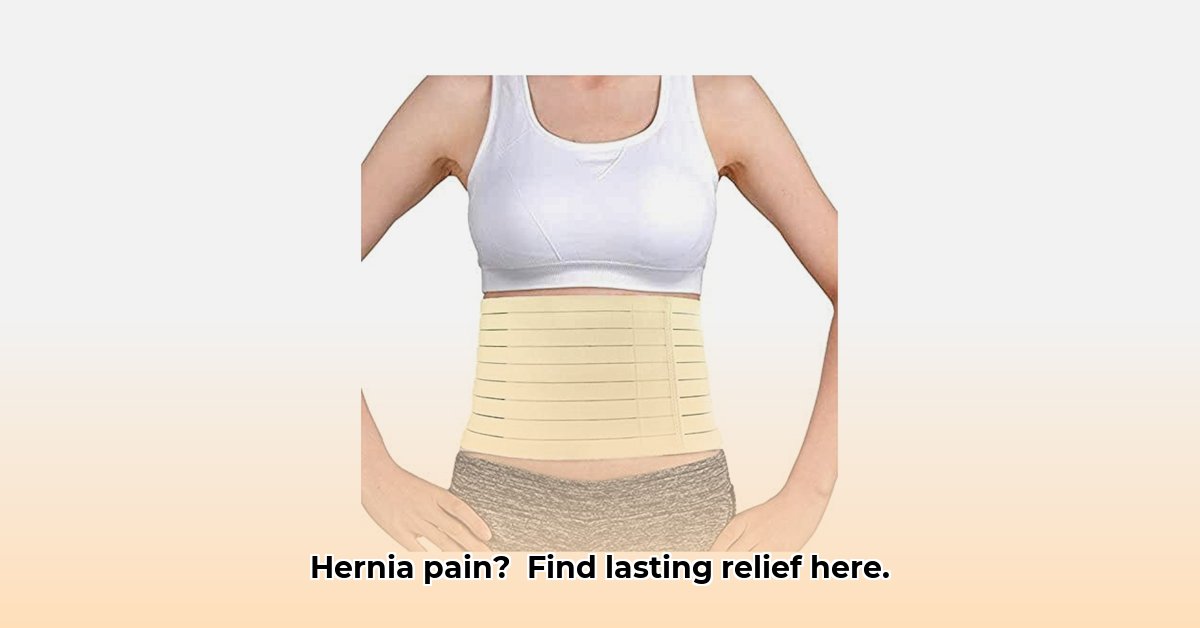Dealing with a hernia can be tough, but a hernia belt might help. This guide is all about how women can find the right hernia belt for them. We’ll cover different types of belts, how to choose one that fits perfectly, and how to use it properly. We’ll also share advice from experts and tips from other women who’ve used them. For additional information on managing pain, check out this helpful article on [post-massage headaches](https://mearnes.com/headache-after-massage/). Whether you’re looking for pain relief or just want to learn more about hernia belts, this guide will help you find the support you need to feel better.
Hernia Belt for Women: Finding the Right Support
Dealing with a hernia? It can be a real pain, both literally and figuratively. For women, finding the right support can make a huge difference in managing discomfort and getting back to your life. This guide will walk you through everything you need to know about hernia belts for women, how they work, and how to choose the best one for your needs, offering potential inguinal hernia pain relief.
Understanding Hernias: What’s Going On?
A hernia happens when an organ or fatty tissue pushes through a weak spot in the surrounding muscle or connective tissue. It’s like a bulge forming where it shouldn’t be. Common types in women include:
- Inguinal hernias: Occur in the groin area.
- Umbilical hernias: Develop around the belly button.
- Incisional hernias: Arise at the site of a previous surgical incision.
- Femoral hernias: Located in the upper thigh/groin.
These can create a noticeable bulge, often accompanied by pain or discomfort. The level of discomfort varies widely; some women can continue daily life relatively normally, while others might experience significant limitations.
Are you noticing a persistent bulge? Experiencing pain, especially when exercising, coughing, or lifting? These are potential signs you might want to discuss with a doctor. A hernia belt might provide some relief and support.
Causes and Risk Factors
Several factors can contribute to the development of a hernia in women:
- Pregnancy: The increased abdominal pressure during pregnancy can weaken abdominal muscles.
- Obesity: Excess weight puts added strain on the abdominal wall.
- Chronic Coughing: Persistent coughing can increase intra-abdominal pressure.
- Straining During Bowel Movements: Constipation and straining can weaken the abdominal muscles over time.
- Previous Abdominal Surgery: Incisions can weaken the abdominal wall, increasing the risk of incisional hernias.
- Age: Muscles naturally weaken with age.
- Genetics: Some individuals may have a predisposition to weaker connective tissues.
How a Hernia Belt Works: Gentle Support
A hernia belt acts like a gentle hug for your abdomen, providing comfortable compression to the affected area. This targeted pressure offers several potential benefits:
- Muscle Support: It helps support the weakened muscles, preventing further bulging or strain.
- Pressure Relief: The compression reduces pressure on the herniated organ, decreasing discomfort.
- Pain Management: Many women report significant pain reduction with consistent use of a high-quality belt.
- Reduced Risk of Aggravation: By providing support, the belt helps prevent the hernia from worsening due to physical activity.
It’s important to remember that this compression should be supportive, not restrictive. It’s designed to provide comfort and support, not to squeeze or constrict.
Choosing the Right Hernia Belt: A Personalized Approach
Picking the perfect hernia belt involves several key considerations:
- Location, Location, Location: The most important factor is the location of your hernia. The belt needs to be designed to support precisely that area. A belt meant for an umbilical hernia won’t necessarily work for an inguinal hernia. Look for belts specifically designed for your type of hernia.
- Finding the Perfect Fit: A poorly fitting belt is useless and can even make things worse. It needs to be snug but not too tight; comfortable yet supportive. Always follow the manufacturer’s sizing guidelines, and don’t hesitate to try on different sizes or styles. Many belts offer adjustable straps for a customized fit.
- Material Matters: Think breathability. No one wants a sweaty, itchy belt rubbing against their skin. Look for breathable, comfortable materials like cotton, neoprene, or moisture-wicking fabrics. Some belts also feature hypoallergenic materials for sensitive skin.
- Support Level: Belts offer varying degrees of compression. Some provide gentle support, while others offer firmer compression, depending on the severity of the hernia and your individual needs. Your doctor can help determine the level of support best suited for you.
- Pad Design (if applicable): Some hernia belts come with a pad that provides additional targeted support to the hernia. Ensure the pad is comfortable and positioned correctly. Removable pads allow for customization.
- Ease of Use: Consider how easy the belt is to put on and take off, especially if you have limited mobility. Look for features like Velcro closures or adjustable straps.
- Discreetness: If you plan to wear the belt under clothing, consider its profile and how easily it can be concealed. Slimmer designs are often more discreet.
Before you buy anything, talk to your doctor. They can advise you on the type and level of support that will best address your specific situation and ensure you choose a safe and suitable solution.
Using Your Hernia Belt: Tips for Success
Once you’ve got your hernia belt, using it correctly is essential for maximizing its benefits:
- Perfect Fit is Key: Refer to the manufacturer’s instructions for proper sizing and how to wear the belt correctly. Getting the fit right is crucial. Make sure the belt is snug but not overly tight.
- Consistency is Crucial: Wear it consistently as directed by your doctor. This consistent support is key to experiencing the full benefits. Typically, this means wearing it during activities that exacerbate your symptoms, such as exercise or prolonged standing.
- Skin Care is Important: Check your skin regularly for any signs of irritation or discomfort. If you experience any redness, rash, or unusual sensations, remove the belt and contact your doctor immediately. Consider wearing a thin layer of clothing under the belt to protect your skin.
- Gradual Introduction: If you’re new to wearing a hernia belt, start by wearing it for short periods and gradually increase the wearing time as you become more comfortable.
- Proper Positioning: Ensure the belt is positioned correctly to provide optimal support to the hernia. Follow the manufacturer’s guidelines. If using a belt with a pad, make sure the pad is directly over the hernia.
- Cleaning and Maintenance: Follow the manufacturer’s instructions for cleaning and maintaining your hernia belt. Regular cleaning helps prevent skin irritation and prolongs the life of the belt.
Remember, a hernia belt is a supportive aid, but it’s not a cure-all. It is likely most effective when used alongside other recommended treatments, such as physical therapy, lifestyle changes, or, in some cases, surgery.
When to Seek Medical Attention: Recognizing Warning Signs and Complications
While hernia belts can offer welcome relief, they are not a replacement for professional medical care. If you notice any of the following, seek immediate medical attention:
- Increasing Pain or Swelling: A significant increase in pain or swelling could indicate a serious complication.
- Changes in Hernia Appearance: Any changes in the size or appearance of the hernia, such as a sudden increase in size or a change in color, warrant immediate medical evaluation.
- Nausea or Vomiting: These symptoms could indicate a more serious issue and should not be ignored.
- Inability to Reduce the Hernia: If you are unable to gently push the hernia back into place, it could indicate incarceration, a serious condition requiring immediate medical attention.
- Fever: Fever in conjunction with a hernia could indicate an infection.
- Constipation or Inability to Pass Gas: These symptoms could indicate a bowel obstruction.
Lifestyle Modifications for Hernia Management
In addition to wearing a hernia belt, certain lifestyle modifications can help manage your condition:
- Maintain a Healthy Weight: Losing weight can reduce pressure on the abdominal wall.
- Avoid Heavy Lifting: If you must lift heavy objects, use proper lifting techniques (bend your knees, keep your back straight).
- Manage Chronic Coughing: Seek treatment for any underlying conditions that cause chronic coughing.
- Prevent Constipation: Eat a high-fiber diet, drink plenty of water, and consider using stool softeners if needed.
- Strengthen Abdominal Muscles: Engage in exercises that strengthen your abdominal muscles, but avoid exercises that put excessive strain on the area. Consult with a physical therapist for guidance.
- Quit Smoking: Smoking can weaken connective tissues.
Weighing the Pros and Cons: Making an Informed Decision
To help you make an informed decision, let’s weigh the potential advantages and disadvantages of using a hernia belt:
| Pros | Cons |
|---|---|
| Pain relief and increased comfort | May not be suitable for all hernia types or severities |
| Supports weakened muscles | Can cause discomfort if worn incorrectly or for too long |
| Relatively inexpensive and easy to use | Not a cure for hernias; addresses symptoms, not the underlying cause |
| Improves mobility for some individuals | May not offer sufficient support in all cases |
- Achieve Anesthesiology Work-Life Balance: Your Guide - December 4, 2025
- Unlock Young Doctors’ Work-Life Balance: Actionable Strategies Now - December 2, 2025
- Unlock Life Harmony: Work-Life Integration Guide - November 30, 2025
















